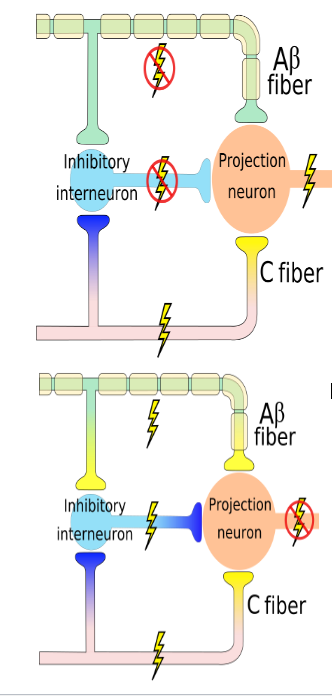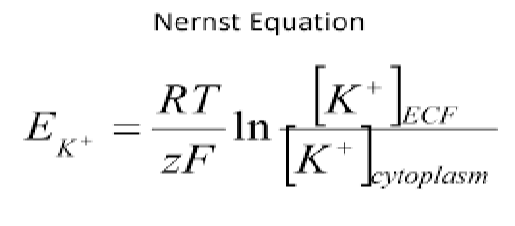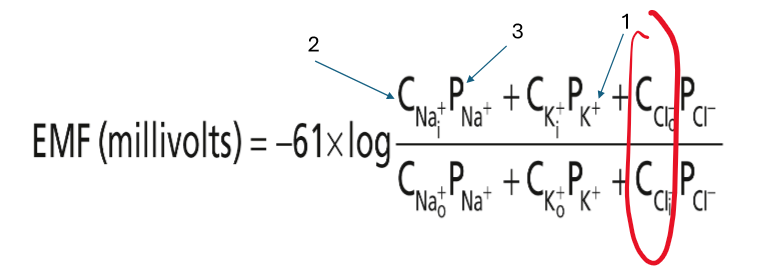Resting Membrane Potential
1/16
There's no tags or description
Looks like no tags are added yet.
Name | Mastery | Learn | Test | Matching | Spaced |
|---|
No study sessions yet.
17 Terms
Give two examples on how galvanic current could be used as a therapeutic device
Iontophoresis
use of direct current to drive an ionized drug through the skin
Transdermal drug delivery
mild electrical current
Pain management
Direct current blocks nocioceptive signals
current “overwhelms” the small diameter pain fibers (C fibers) → Shuts gate in spine
Describe the gate control theory of pain management
Normally: stimulation of C fibers stimulates the projection neurons in the dorsal horn and thus sends the pain signals on to the brain (A)
Applying an electrical current to the area in pain does the following:
Activation of the inhibitory interneurons and larger Aβ fibers → stops nocioceptive signals
Pressure (massage) can also do this by activating the large diameter Aβ fibers

What is the membrane potential necessary for? how is this Charge differential created?
necessary for signaling (particularly in neuromuscular systems)
Potential created via movment of ions through protein carriers
What are the four types of ion channels?
Voltage gated channels
Common: Na, K, Ca
Open due to change in membrane voltage
Ligand-gated channels
Binds ligand to open (ex: Acetylcholine)
Constitutively open
“leak” channels
Na, K
EnaC: epithelial sodium channels
Gap Junction
Near-instantaneous transmission of signal
open via change in voltage, pH or Ca ions
Ex: Intercalated discs in cardiac muscle
Describe the different structures of the different ion channels
Central Pore
Different subunits for different ion channel function
Voltage gated: 4 subuints
Ligand gated: 5 subunits
Gap junction: 6 subunits
ENaC channel: 3 subunits
Describe the mechanism for depolarization and repolarization of action potential
Depolarization
opening of voltage-gated sodium channels → Na enters → more positive cell
Repolarization
Closure of voltage-gated sodium channels; Opening of voltage-gated potassium channels → K leaves cell → more negative cell
What is equilibrium potential? What formula do we use to calculate this?
Equilibrium potential: The voltage at which each individual ion prefers the cell
We use the Nernst Equation to calculate this

What is the equilibrium potential of Na and K? Explain the logistics for these equilibrium potentials
K: - 95; potasium [] is high inside; low outside; thus it wants to go out
Na: + 67; Na [] is high outside; low inside; thus it wants to go in
Why is the membrane potential of neuron cells extremely similar to K+ equilibrium potential at rest?
This is because potassium has the most conductance at rest (80-100 % of conductance is by K+)
This is because K+ channesl are “leak” channels whilst Na+ channels are voltage gated
Thus, K+ channels are always open
What happens if we add K+ into the extracellular environment? What happens if we remove K+ from extracellular environment?
Add:
Cell depolarizes due to reduced K+ movement out
Remove:
Cell hyperpolarize due to increased K+ out
What is the Goldman equation? Based on this equation? What are the three factors that dictate membrane potential
Gives a cell’s membrane potential; espeically when its membarne is permeable to several ions
Factors that dictates membrane potential
Polarity (direction) of each ion
Concentration difference across membrane for each ion
Permeability of membrane to each ion

What is Ohm’s Law?
I=V/R or I = VxG
I= current
V= voltage
R = resistence
G = Conductance
What are the main ions that dictate membrane potential for:
Skeletal muscles/nerve?
Smooth muscles?
Respiratory tracts?
Muscles/nerves: K/Na
Smooth muscles: Ca/K
Respiratory tract: Mucous secretions
Define the Electrochemical Driving Force
Difference between the actual membrane potential (Vm) and the equilibrium potential (Veq) for a given ion
Net driving force (Vdf) = Vm-Veq
What is the movement of ions depended on? What is conductance dependent on?
Dependent upon both driving force and ionic conductance
Conductance: Determined by ion channel number and probability that it is open
How do we measure membrane potential?
One electrode filled with an electrolyte solution
impaled through the cell membrane into the interior of the fiber
Another is in the extracellular fluid space
The “indifferent electrode”
Measures the voltage difference on either side of the membrane
Besides the ECF of Na/K? What is another contributor to resting membrane potential?
Na-K ATPase pump
Small contributor; makes interior -4mV
Small leakage of Na into the cell; Pumps pump those Na out (3:2 ration; 3Na for 2K)